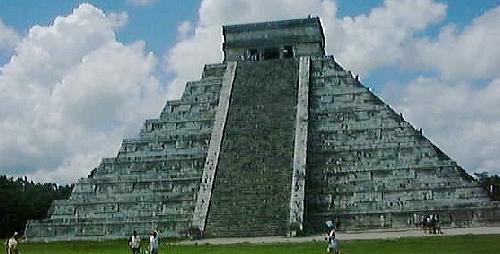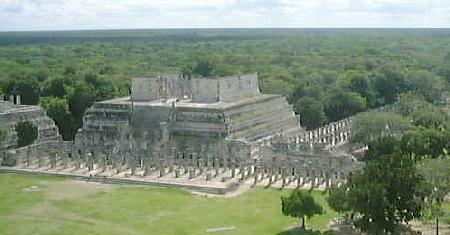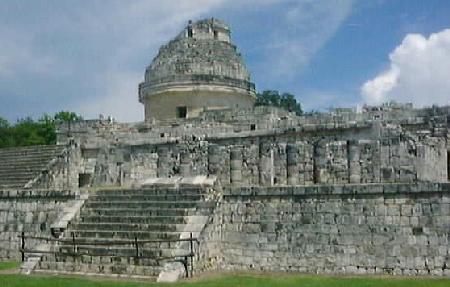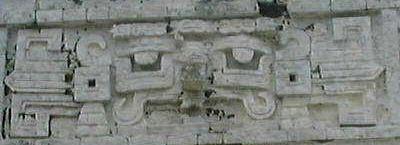
Chichen Itza, Yucatan

El Castillo, Chichen Itza
Tuesday September 7th 1999
We made our way to Chichen Itza from Merida early in the morning to avoid the press of crowds arriving from the beach resort of Cancun. We had been greatly looking forward to visiting the site, but we were both very disappointed. Almost all of the buildings were fenced off and closed to tourists (the exception being the castle pyramid), so that we could not see much of what we wanted to. Also the entrance charge was three times that of Teotihuacan, which is a much more impressive site. We both came away feeling somewhat cheated, especially since from ground level many of the most interesting things are completely invisible. I'd go back to Tula, Teotihuacan and Palenque again, but unless things change considerably for the better, I wouldn't go back to Chichen Itza. Perhaps we wouldn't feel so bad if we hadn't visited so many other sites, but we both felt that we'd been ripped off. Having said that, Chichen Itza is still very impressive.
The first settlement of Chichen Itza was, most scholars agree, pure Maya. For reasons unknown, the city was largely abandoned in the 9th century, and nobody knows why. The Mayan scripts state that much of the Yucatan was conquered towards the end of the 10th century by Kukulcan, who has been identified with Quetzalcoatl, the plumed serpent god. The generally accepted theory is that Topiltzin, a worshipper of Quetzalcoatl, left Tula near Mexico City and established himself at Chichen Itza; this is not however universally accepted, and many people believe that the connection between Tula and Chichen Itza lies in the opposite direction. In any event, there are numerous similarities between the two sites which are probably not coincidental. In particular, Chichen Itza's Temple of the Warriors is very similar to Pyramid B at Tula, and both sites had chac-mools, reclining human figures holding on their stomachs receptacles, which were probably used to hold human hearts ripped out during ritual sacrifices. Unfortunately, we were not allowed to climb up the Temple of the Warriors to check on these similarities for ourselves.
In the 10th century the site was re-settled, and a new culture was born, a mixture of Toltec and Maya. This was the period when Chichen Itza was at its greatest. Some time afterwards, a Mayan leader moved the political capital to Mayapan while retaining Chichen Itza as the religious capital. Chichen Itza went into decline, and was eventually abandoned in the 14th century, although it remained a site of Mayan pilgrimage for a long time afterwards.
The centrepiece of the site would appear to be the main pyramid, called the castle by the Spanish. 25 metres high, it was originally built before 800 AD before the Toltec invasion. Nevertheless, it shows the plumed serpent along the stairways and Toltec warriors on the door carvings in the temple on top. This has supported counter-theories that Tula was influenced by Chichen Itza and not the other way around.
The pyramid actually embodies the Mayan calendar. The nine levels are divided in two by a staircase, making a total of 18 sections, representing the months of the haab, the "vague" year. The four stairways each have 91 steps; adding the top platform makes a total of 365, the number of days of the year. Each facade of the pyramid had 52 flat panels, representing the number of years in the "calendar round". The Mayan calendar actually had two types of year: the tzolkin ("sacred" or "almanac" year) consisting of 13 periods of 20 days; and the haab, consisting of 18 months of 20 days and the uayeb, a five-day "portentous" period. These two types of year completed a 52-year cycle called the calendar round, within which any date could be located precisely. These two counts were common to all of Mexico's pre-Hispanic civilisations. However, the Maya also had a third system, known as the long count, using units of 1, 20, 360, 7200 and 144,000 days, which could be extended indefinitely. Mayan inscriptions show the number of Long Count units which had passed from a starting point, the Mayan creation date, corresponding to August 13th 3114 BC.
During the equinoxes (March 21 and September 21), the sun makes a pattern of light and shadows along the steps of the pyramid, creating a series of triangles which appear to form the shape of a serpent crawling up the pyramid. We didn't visit Chichen Itza at the right time for this, but we saw pictures and it looked pretty impressive. The pyramid also contains another pyramid inside, containing a jaguar throne and a Toltec-style chac mool figure. To visit this inner pyramid, you have to wait in a long line in the heat with no shade, and then you only get to glimpse the throne from behind a metal fence for a few moments before you have to move on to let other people see.
One of the most impressive sights at Chichen Itza is the so-called Group of the Thousand Columns, named after the many pillars, which presumably supported a roof originally, in front of the buildings. The group consists of the Temple of the Warriors, with similarities to Tula's pyramid B, the Temple of Chac Mool inside the Temple of the Warriors, and the Steam Bath, which was used for ritual purification. Unfortunately, we were not allowed to see the Temple of Chac Mool, or climb the Temple of the Warriors, and had to be content with viewing it from a distance.

Temple of the Warriors, Group of the Thousand Columns, Chichen Itza
The main ball court is the largest in Mexico at 135 metres in length, and has temples at either end and stone hoops high up in the side walls. The side panels of the court have panel carvings representing the ball game which suggest that the game changed over time - some of them show players with knee- and elbow-padding, while others show players using bats. The theory is that if a player hit the ball through one of the loops in the wall, his team was declared the winner. There are seven other ball courts located around the site. The temples at either end of the ball court and on one side appeared to have impressive, well-preserved carvings and decorations, but like so much of Chichen Itza, these were closed to visitors, so we couldn't get to see them.
Nearby is the Tzompantli, "temple of skulls" in Toltec. It is believed that this platform held the heads of sacrificial victims. All along the walls on every side are many carvings of skulls.
About 300 metres to the north along a paved Mayan road is the sacred cenote. Cenotes are natural limestone sinkholes containing water found all over the Yucatan. Some were used for drinking water (indeed some still are), but the Sacred Cenote, 60 metres across and 35 metres deep. The sacred cenote has been dredged and explored on a number of occasions, and human remains as well as artefacts and valuable gold and jade jewellery were found. Some of the pieces came from as far afield as Colombia.

The Observatory, Chichen Itza
A short distance through the jungle away from the castle pyramid is another group of buildings, all of which were closed to visitors, and we could only observe them from afar. The most impressive was the observatory, a circular building on top of a platform with numerous windows, apparently aligned to the position of certain stars on specific dates. The priest class would announce the timing of rituals, celebrations, planting and harvests from the observatory's dome.
The final group of buildings was called the Nunnery by the Spanish, as its many rooms reminded them of a convent. Once again these were closed to visitors, but it was possible to see some of the intricate carvings of the "big-nosed god" which decorate the buildings.

Carving of the "big-nosed god", Chichen Itza
Previous | Mexico index | Travel index | Family history | Romany | Main index